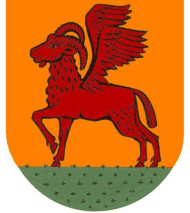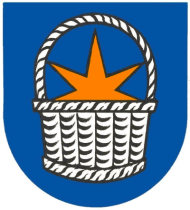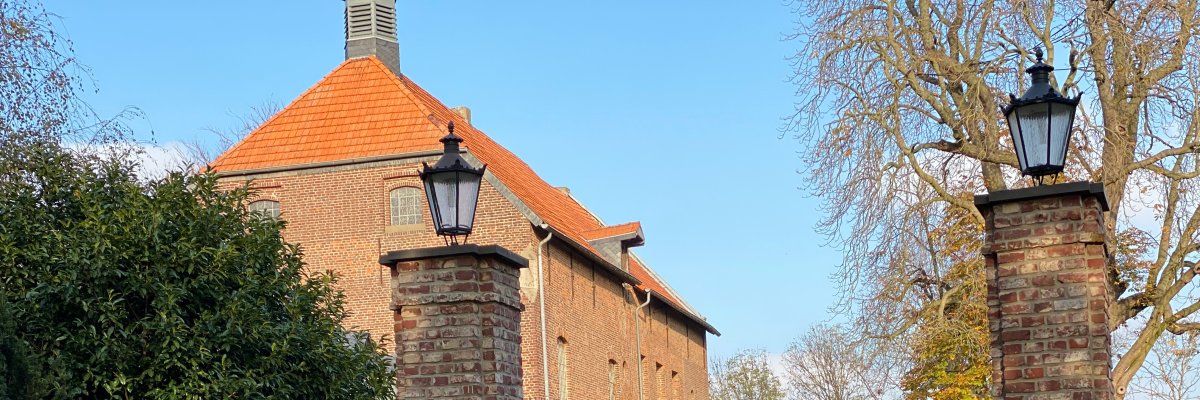Kervenheim
The village of Kervenheim has a population of 2,189 (as at 31.12.2023) and covers an area of 1,560 hectares. The rural village is not only very popular with nature lovers and cyclists, but is also an interesting location for commercial enterprises thanks to its direct connection to the highway. The well-preserved medieval Kervenheim Castle dating back to 1270 is one of the oldest castle complexes on the Lower Rhine and is a popular meeting place for the local population and for events.
Coat of arms

Kervenheim took its coat of arms from the town seal of 1791, the year in which Kervenheim was granted town rights.
History
The oldest information about land ownership in the Kervenheim area refers to the Villa Geizefurt with several sub-estates from the year 855, a gift from King Lothar II to Count Palatine Ansfried; the latter transferred Geizefurt to Lorsch Monastery in Rheinhessen eleven years later. The Gochfortsberg, located near Kervenheim, is also mentioned in the boundary description of this estate. There are no other sources that could provide more detailed information about the Lorsch estate.
Kervenheim Castle, first mentioned in documents in 1270 and usually referred to as Kervendonk Castle, is one of the oldest castle complexes on the Lower Rhine. According to a deed of sale from 1270, Count Stefan von Wissel transferred Kervenheim Castle to Count Dietrich von Cleve.
Kervenheim was first documented as a town in 1322 and can be traced back to the French period in 1794. From 1332, it was one of the 24 towns in the County of Cleves (since 1417 Duchy of Cleve). Between 1412 and 1417, Kervenheim had its own magistrate's office at the castle; before that, Kervenheim presumably belonged to the court of Winnekendonk, then after 1417 to the court of Uedem. From 1439, the courts of Kervenheim and Winnekendonk formed the Schravelen magistracy. The name comes from the official seat of the judges, who resided at Haus Schravelen, a castle on the Niers - which has long since disappeared.
In 1445, Kervenheim was given its own parish, having previously belonged to the parish of Winnekendonk. The castle chapel was elevated to a parish church. A single-nave church of St. Anthony was built in Kervenheim around 1500 (the church was extended in 1775, 1839 and 1888). Even today, two wooden sculptures from the Kalkar carving workshop of Henrik van Holt (created around 1540) can be admired in the parish church of St. Anthony in Kervenheim. At the beginning of the 17th century, the Reformed parish became the tenant of the castle church (since the end of the 19th century, the Protestant church has owned the part of the castle it uses). In 1757, the magnificent Kervendonk Castle and half the village (38 houses) burned down, the cause of the fire remains unknown. It was not completely rebuilt, but only the existing Protestant church in the castle and a manor house with outbuildings "Haus Kervendonk" were rebuilt. In the 18th century, the population of Kervenheim lived mainly from agriculture and distilling spirits. In 1771 there were three mills in Kervenheim, a water mill, a horse mill and an oil mill.
After the final dissolution of the Schravelen magistrate's office, Kervenheim and Winnekendonk were united in 1798 to form a mayor's office with its seat in Kervenheim; from the 1950s onwards, the seat moved to Winnekendonk. In the second half of the 19th century, the shoe factory settled in Kervenheim, which remained important until the late 20th century. The municipality of Kervenheim (Amt Kervenheim), which had been independent since the founding of the district of Geldern (1816), was incorporated into the town of Kevelaer in 1969. In the state competition "Our village should become more beautiful", now renamed "Our village has a future", Kervenheim won a bronze medal in 2003 and a silver medal in 2006
Kervendonk

Coat of arms
The basket motif is an earlier symbol for hometown from the language area of the prefix. Thus the image of the basket became the word "Kerv", which gave the town its name and as part of the name, it in turn became part of the symbolism of the coat of arms: pars pro toto.
Kervendonk was an independent municipality in the Amt Kervenheim until the municipal reorganization on July 1, 1969. Today, the former municipalities of Kervenheim and Kervendonk together form the village of Kervenheim.
History
Kervendonk, the area around Kervenheim, between the towns of Kevelaer, Winnekendonk, Uedem, Weeze and Sonsbeck, has always been characterized by agriculture. The secular and ecclesiastical history of Kervendonk has always been closely intertwined with the history of Kervenheim. Some of the farmsteads of Villa Geizefurth, described in more detail under Kervenheim, were most probably located in the northern and western part of Kervendonk.
The center of Kervendonk was the castle of Kervendonk or Kervenheim, first mentioned in 1270. The Kervendonk area, especially to the north and west of Kervenheim, originally belonged to the county of Geldern, just like Kervenheim itself, but in 1332 it became part of the county of Kleve, which had already acquired Schravelen in 1250, which was probably not included in Kervendonk during the Middle Ages. The Niers used to form the natural border between the counties and duchies of Kleve and Geldern in the Schravelen area.
At the beginning of the 15th century, Duke Adolf von Kleve had a fortress built in Schravelen on the Niers next to the 14th century domain mill, the "Schravelschen Wassermühle", which was later known as "Haus Schravelen". For 350 years from 1439, Schravelen House was the official residence of the Schravelen magistrates, but today it has long since disappeared. The "Schravelsche Wassermühle", on the other hand, still exists today. However, the mill ceased operation in the 1920s.
Presumably while Count Adolf von Kleve was fortifying his borders on the Niers, the Brembt or Steens manor (documented since the 16th century) was built 500 meters to the north. Today there is a large farm on the site.
During the reign of Louis XIV, a large part of the Kervendonk farms and cathouses were set on fire in 1669 due to non-payment of high war contributions to the French.
As far as can be verified, pottery has been made in Kervendonk since the beginning of the 18th century. Some of the pottery misfires were unearthed in the 20th century and can be admired. Two original potter's houses can still be seen today on the outskirts of Kervenheim.
The old Schravelen magistrate's office was dissolved in 1798 and Kervenheim, Kervendonk and Winnekendonk were united to form a mayor's office. When the district of Geldern was founded in 1816, Kervendonk (Amt Kervenheim) became independent. In the mid-60s of the 19th century, the houses, farmsteads and Katstellen formerly belonging to Kervendonk, which lay on the municipal border with Winnekendonk and Kevelaer, were separated and assigned to Winnekendonk. Around 1870, a mighty windmill was erected on the outskirts of Kervenheim, in the immediate vicinity of today's intersection of Kervenheim - Winnekendonk and Schloss Wissen - Uedem. The "Mott Mill" windmill was decommissioned in 1945. Kervendonk was incorporated into the town of Kevelaer in 1969, as was the entire district of Kervenheim.

